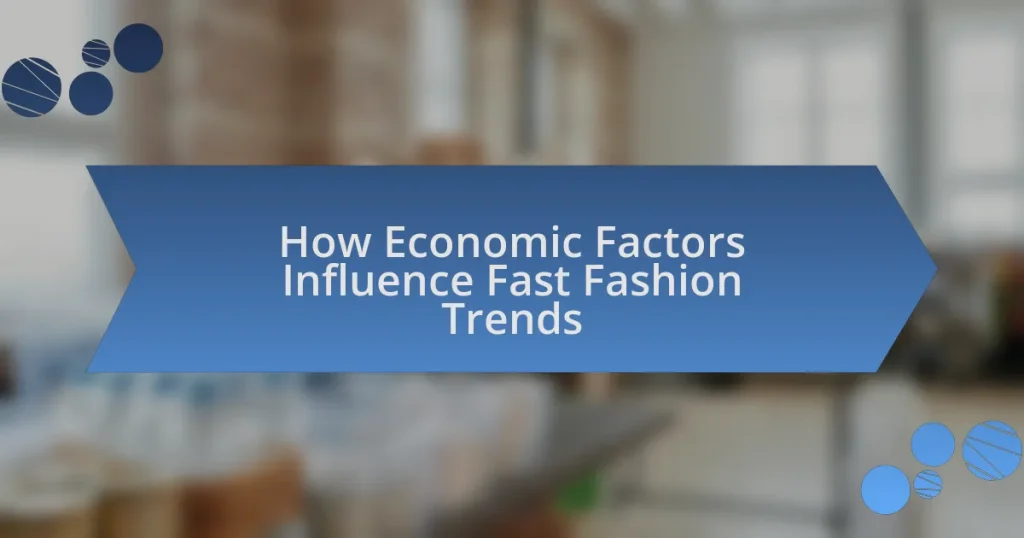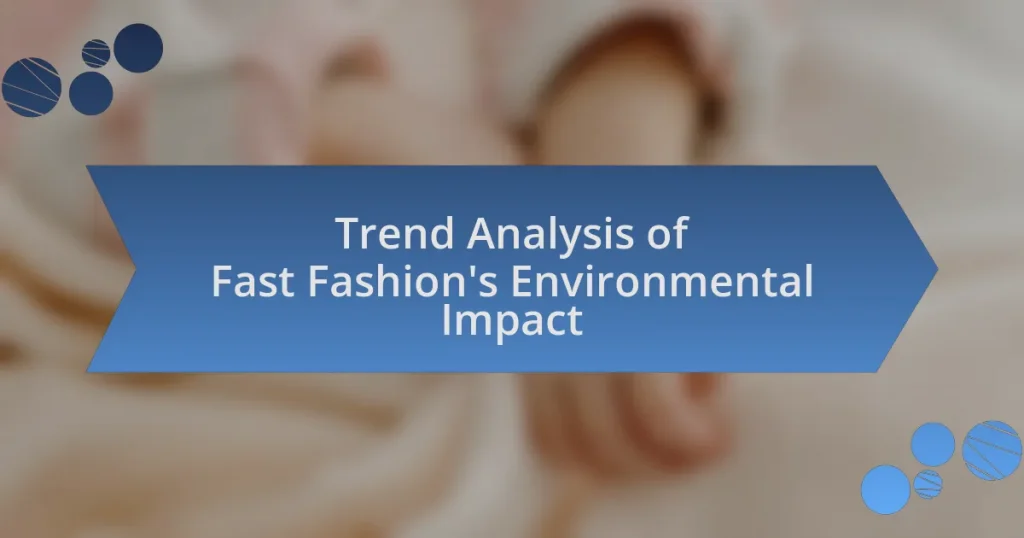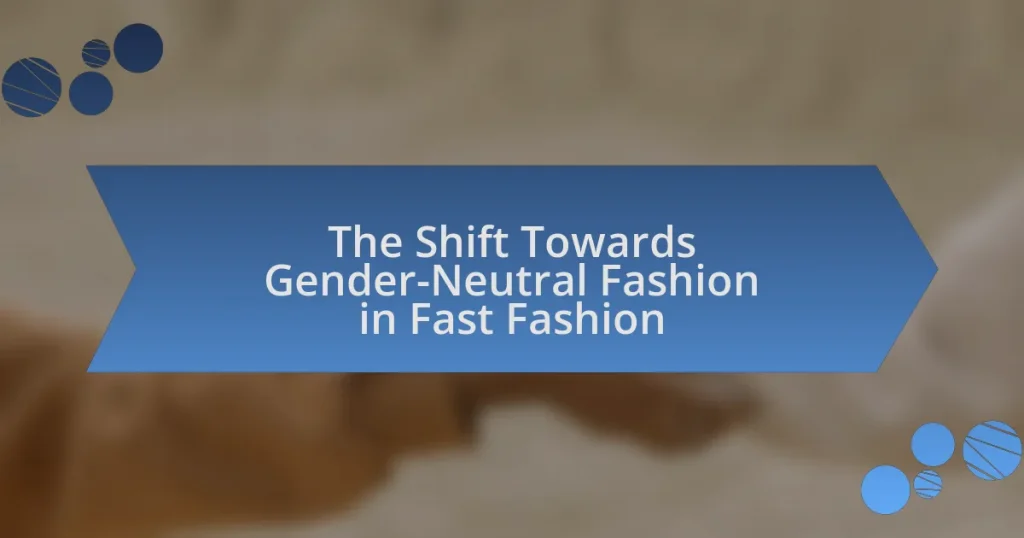The article examines how economic factors influence fast fashion trends, highlighting the relationship between consumer purchasing power, demand for affordable clothing, and production strategies of fast fashion brands. Key economic elements such as consumer demand, production costs, and global supply chain dynamics are discussed, illustrating their impact on brand strategies during economic fluctuations. The article also explores how recessions and economic booms affect consumer behavior, purchasing habits, and brand loyalty, emphasizing the importance of adapting to changing economic conditions for sustained growth in the fast fashion industry. Additionally, it addresses the role of sustainability and innovative practices in enhancing competitiveness amid economic challenges.
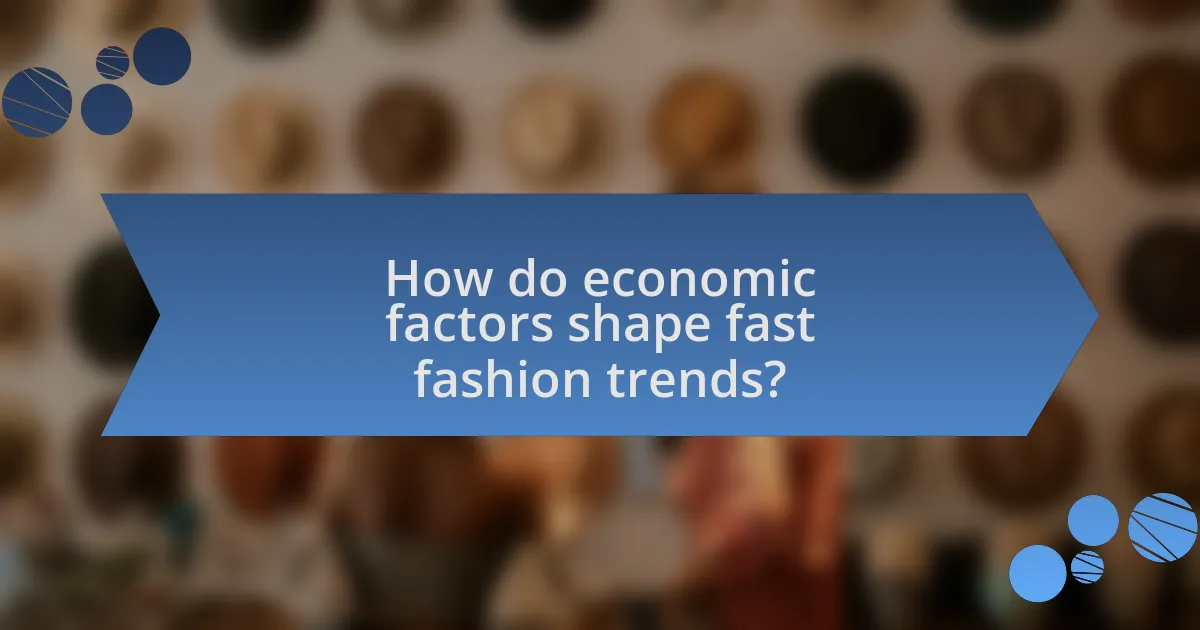
How do economic factors shape fast fashion trends?
Economic factors significantly shape fast fashion trends by influencing consumer purchasing power and demand for affordable clothing. When economic conditions are favorable, such as during periods of economic growth, consumers tend to spend more on fashion, driving brands to produce trendy, low-cost items rapidly. Conversely, during economic downturns, consumers prioritize budget-friendly options, prompting fast fashion retailers to adapt their offerings to meet this demand. For instance, a report by McKinsey & Company highlights that in 2020, the global fashion industry faced a 93% decline in sales due to the COVID-19 pandemic, forcing brands to pivot towards more affordable collections to retain customer interest. Thus, economic conditions directly impact the strategies and product lines of fast fashion brands, shaping the overall trends in the industry.
What are the key economic factors influencing fast fashion?
The key economic factors influencing fast fashion include consumer demand, production costs, and global supply chain dynamics. Consumer demand drives fast fashion brands to quickly produce trendy clothing at low prices, responding to the desire for affordable and fashionable apparel. Production costs, influenced by labor costs and material prices, affect how brands source their products; lower costs often lead to higher profit margins. Additionally, global supply chain dynamics, including trade policies and logistics, impact the speed and efficiency with which brands can deliver new collections to market. For instance, the global textile market was valued at approximately $920 billion in 2021, highlighting the significant economic scale of the industry and its responsiveness to these factors.
How does consumer purchasing power affect fast fashion demand?
Consumer purchasing power directly influences fast fashion demand by determining the affordability of trendy clothing. When consumers have higher purchasing power, they are more likely to spend on fast fashion brands, which offer low-cost, quickly produced apparel. For instance, during economic upturns, disposable income increases, leading to a rise in demand for fast fashion items, as evidenced by a 2019 report from McKinsey & Company, which noted that consumer spending in the fashion sector grew by 4% in regions with rising disposable incomes. Conversely, when purchasing power declines, such as during economic recessions, demand for fast fashion typically decreases, as consumers prioritize essential goods over discretionary spending. This relationship highlights the sensitivity of fast fashion demand to fluctuations in consumer purchasing power.
What role do global economic conditions play in fast fashion production?
Global economic conditions significantly influence fast fashion production by affecting consumer purchasing power, supply chain costs, and market demand. When economies are strong, consumers tend to spend more on clothing, driving fast fashion brands to increase production to meet heightened demand. Conversely, during economic downturns, reduced disposable income leads to decreased spending on non-essential items, prompting brands to adjust their production levels accordingly. Additionally, fluctuations in global trade policies and currency exchange rates can impact the cost of raw materials and labor, further influencing production strategies. For instance, a 2020 report by McKinsey & Company highlighted that the COVID-19 pandemic caused a dramatic shift in consumer behavior, leading to a 30% decline in global fashion sales, which directly affected fast fashion production volumes.
Why is fast fashion sensitive to economic fluctuations?
Fast fashion is sensitive to economic fluctuations because consumer spending power directly impacts demand for affordable clothing. During economic downturns, consumers tend to prioritize essential purchases, leading to decreased sales for fast fashion brands. For instance, a report from McKinsey & Company in 2020 indicated that the global fashion industry faced a 93% decline in sales during the initial months of the COVID-19 pandemic, highlighting how economic instability can drastically affect consumer behavior and brand performance. Additionally, rising production costs due to inflation can force fast fashion retailers to increase prices, further reducing demand in a sensitive economic climate.
How do recessions impact fast fashion sales and strategies?
Recessions negatively impact fast fashion sales and strategies by reducing consumer spending and shifting purchasing priorities. During economic downturns, consumers tend to prioritize essential goods over discretionary items, leading to a decline in sales for fast fashion retailers. For instance, a report from McKinsey & Company indicated that during the 2008 financial crisis, the global apparel market contracted by 10%, significantly affecting fast fashion brands that rely on high-volume sales. In response, fast fashion companies often adjust their strategies by increasing promotional activities, offering discounts, and focusing on value-oriented products to attract budget-conscious consumers. This shift in strategy aims to maintain sales volume despite the challenging economic environment.
What happens to fast fashion trends during economic booms?
During economic booms, fast fashion trends typically experience increased consumer demand and rapid sales growth. This surge is driven by higher disposable incomes, which enable consumers to spend more on clothing and accessories. For instance, during the economic expansion from 2010 to 2019, the global fast fashion market grew significantly, with brands like Zara and H&M reporting double-digit sales increases. This trend reflects consumers’ willingness to purchase trendy, affordable clothing, leading to a faster turnover of styles and collections in the fast fashion industry.
How do economic policies influence fast fashion brands?
Economic policies significantly influence fast fashion brands by shaping production costs, consumer purchasing power, and regulatory environments. For instance, tariffs on imported textiles can increase costs for fast fashion retailers, leading to higher prices for consumers or reduced profit margins for brands. Additionally, economic policies that promote trade agreements can lower costs by facilitating cheaper imports, allowing fast fashion brands to maintain low prices and rapid inventory turnover. Furthermore, policies related to minimum wage and labor rights can impact operational costs, as brands may face pressure to improve working conditions or wages in manufacturing countries. These dynamics illustrate how economic policies directly affect the operational strategies and market positioning of fast fashion brands.
What impact do tariffs and trade agreements have on fast fashion pricing?
Tariffs and trade agreements significantly influence fast fashion pricing by affecting the cost of imported materials and finished goods. When tariffs are imposed on textiles and apparel, the increased costs are often passed on to consumers, leading to higher retail prices. For example, the U.S.-China trade war resulted in tariffs as high as 25% on certain clothing items, which directly impacted the pricing strategies of fast fashion retailers. Conversely, favorable trade agreements can lower tariffs, reducing costs and allowing brands to offer lower prices. The North American Free Trade Agreement (NAFTA) facilitated lower tariffs on apparel produced in Mexico, benefiting U.S. fast fashion companies by decreasing their overall production costs. Thus, the interplay of tariffs and trade agreements plays a crucial role in shaping the pricing landscape of the fast fashion industry.
How do labor laws and regulations affect fast fashion supply chains?
Labor laws and regulations significantly impact fast fashion supply chains by enforcing standards for worker rights, wages, and working conditions. These laws compel brands to ensure compliance with minimum wage requirements, overtime pay, and safe working environments, which can increase production costs. For instance, the implementation of the Bangladesh Accord on Fire and Building Safety after the Rana Plaza disaster in 2013 led to heightened scrutiny of labor practices in garment factories, resulting in improved safety measures but also higher operational expenses for brands. Consequently, fast fashion companies may seek to balance compliance with cost efficiency, often leading to sourcing from countries with less stringent regulations to maintain profit margins.
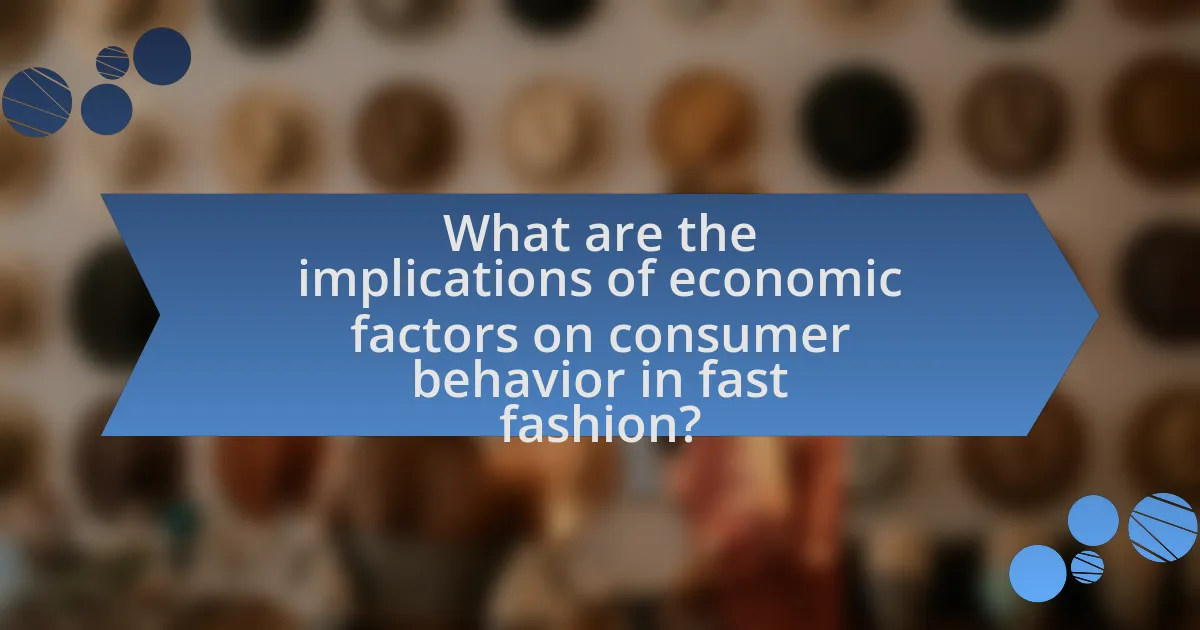
What are the implications of economic factors on consumer behavior in fast fashion?
Economic factors significantly influence consumer behavior in fast fashion by affecting purchasing power, spending habits, and brand loyalty. For instance, during economic downturns, consumers tend to prioritize affordability, leading to increased demand for budget-friendly fast fashion brands. According to a report by McKinsey & Company, 75% of consumers in 2020 indicated that price was a primary factor in their purchasing decisions, highlighting the sensitivity to economic conditions. Additionally, fluctuations in disposable income can shift consumer preferences towards more sustainable or higher-quality options when economic conditions improve, as seen in the rise of ethical fashion brands during economic recoveries. Thus, economic factors directly shape consumer choices and trends within the fast fashion industry.
How do economic conditions affect consumer spending habits in fashion?
Economic conditions significantly influence consumer spending habits in fashion by altering disposable income and consumer confidence. During periods of economic growth, consumers tend to spend more on fashion due to increased disposable income and optimism about their financial future. For instance, in 2021, the global fashion market grew by 21% as economies began to recover from the pandemic, reflecting heightened consumer spending. Conversely, during economic downturns, such as the 2008 financial crisis, consumers often prioritize essential goods over fashion, leading to decreased sales in the industry. Research from McKinsey & Company indicates that during economic recessions, fashion retailers experience a shift towards value-oriented purchases, with consumers seeking discounts and lower-priced items. This behavior illustrates how economic conditions directly shape consumer priorities and spending patterns in the fashion sector.
What trends emerge in consumer preferences during economic downturns?
During economic downturns, consumers tend to prioritize value and affordability in their purchasing decisions. This shift often leads to increased demand for discount retailers and second-hand clothing, as consumers seek to stretch their budgets. For instance, a report by McKinsey & Company highlights that during the 2008 financial crisis, fast fashion brands that offered lower prices saw a surge in sales, while luxury brands experienced a decline. Additionally, consumers may gravitate towards essential items over non-essential luxury goods, reflecting a more pragmatic approach to spending during uncertain economic times.
How do luxury versus budget fashion choices change with economic shifts?
Luxury fashion choices typically decline during economic downturns, while budget fashion choices tend to increase. For instance, during the 2008 financial crisis, luxury brands experienced a significant drop in sales, with a reported 10% decline in the luxury goods market, as consumers prioritized essential spending over high-end purchases. Conversely, budget fashion retailers like H&M and Zara saw growth, capitalizing on the demand for affordable clothing options. This trend illustrates how economic shifts directly influence consumer behavior, leading to a preference for budget-friendly alternatives in times of financial uncertainty.
Why do consumers gravitate towards fast fashion during certain economic periods?
Consumers gravitate towards fast fashion during certain economic periods primarily due to its affordability and accessibility. During economic downturns or periods of financial uncertainty, consumers often prioritize budget-friendly options, leading them to choose fast fashion brands that offer trendy clothing at lower prices. For instance, a study by the Global Fashion Agenda in 2021 indicated that 60% of consumers consider price as the most important factor when shopping for clothing during economic hardships. This trend is further supported by the rapid production cycles of fast fashion retailers, which allow them to quickly respond to changing consumer preferences and economic conditions, making them appealing choices for cost-conscious shoppers.
How does the perception of value influence fast fashion purchases?
The perception of value significantly influences fast fashion purchases by shaping consumer decisions based on quality, price, and brand reputation. Consumers often equate low prices with high value in fast fashion, leading them to prioritize affordability over durability. Research indicates that 60% of fast fashion shoppers consider price as the most important factor in their purchasing decisions, demonstrating that perceived value directly correlates with sales volume in this sector. Additionally, the rapid turnover of trends in fast fashion creates a sense of urgency, further enhancing the perceived value of immediate gratification over long-term investment in clothing. This perception is reinforced by marketing strategies that emphasize limited-time offers and the latest styles, compelling consumers to buy more frequently.
What psychological factors drive fast fashion consumption in varying economies?
Psychological factors driving fast fashion consumption in varying economies include social identity, consumerism, and the desire for status. Social identity influences individuals to purchase trendy clothing to align with peer groups, enhancing their self-image and belonging. In economies with higher disposable income, consumerism is more pronounced, leading to increased purchasing behavior as individuals seek to fulfill emotional needs through material goods. The desire for status is particularly significant in emerging economies, where consumers often buy fast fashion to signal wealth and modernity, reflecting a shift towards global consumer culture. Research indicates that in countries with rapid economic growth, such as China and India, the psychological drive for social acceptance and prestige significantly boosts fast fashion sales, as consumers aspire to emulate Western lifestyles.

How can fast fashion brands adapt to changing economic factors?
Fast fashion brands can adapt to changing economic factors by implementing flexible supply chain strategies and embracing sustainable practices. Flexible supply chains allow brands to respond quickly to shifts in consumer demand and economic conditions, such as inflation or changes in disposable income. For instance, brands can utilize data analytics to forecast trends and adjust production accordingly, minimizing excess inventory and reducing costs. Additionally, adopting sustainable practices can enhance brand loyalty and appeal to environmentally conscious consumers, which is increasingly important in today’s market. According to a 2021 McKinsey report, 67% of consumers consider sustainability when making a purchase, indicating that aligning with consumer values can drive sales even in fluctuating economic climates.
What strategies can fast fashion brands implement during economic downturns?
Fast fashion brands can implement cost-cutting measures, enhance value propositions, and pivot towards sustainable practices during economic downturns. Cost-cutting measures include reducing production costs through streamlined supply chains and negotiating better terms with suppliers, which can help maintain profit margins despite decreased consumer spending. Enhancing value propositions involves offering promotions, discounts, and loyalty programs to attract budget-conscious consumers, as evidenced by a 2020 McKinsey report indicating that 75% of consumers were more price-sensitive during economic challenges. Additionally, pivoting towards sustainable practices can appeal to a growing demographic of environmentally conscious consumers, as a 2021 survey by Deloitte found that 32% of consumers are willing to pay more for sustainable products, potentially offsetting losses from reduced sales volume.
How can brands optimize pricing strategies in response to economic changes?
Brands can optimize pricing strategies in response to economic changes by employing dynamic pricing models that adjust based on market demand, competitor pricing, and consumer purchasing power. For instance, during economic downturns, brands can implement promotional pricing or discounts to maintain sales volume, as evidenced by a study from McKinsey & Company which found that brands that adjusted prices in line with consumer sentiment saw a 20% increase in sales during recessions. Additionally, utilizing data analytics to monitor economic indicators allows brands to anticipate shifts in consumer behavior and adjust prices accordingly, ensuring competitiveness and profitability.
What role does sustainability play in fast fashion during economic shifts?
Sustainability plays a critical role in fast fashion during economic shifts by influencing consumer purchasing behavior and brand strategies. As economic conditions fluctuate, consumers increasingly prioritize sustainable practices, leading brands to adopt eco-friendly materials and ethical production methods to maintain competitiveness. For instance, a 2021 survey by McKinsey & Company found that 67% of consumers consider sustainability when making fashion purchases, indicating a significant shift in consumer values that brands must address to thrive in changing economic landscapes. This trend compels fast fashion companies to integrate sustainability into their business models, impacting their supply chains and marketing strategies to align with consumer expectations.
How can fast fashion brands leverage economic trends for growth?
Fast fashion brands can leverage economic trends for growth by adapting their supply chains and pricing strategies to align with consumer spending patterns. For instance, during economic downturns, these brands can offer lower-priced items to attract budget-conscious consumers, as evidenced by a 2020 McKinsey report indicating that 75% of consumers shifted to more affordable brands during the pandemic. Additionally, fast fashion brands can capitalize on the rise of e-commerce, which saw a 44% increase in online sales in 2020, by enhancing their digital presence and optimizing online shopping experiences. By responding to economic fluctuations and consumer behavior, fast fashion brands can effectively drive sales and expand their market share.
What innovative practices can brands adopt to stay competitive in fluctuating economies?
Brands can adopt agile supply chain management as an innovative practice to stay competitive in fluctuating economies. This approach allows brands to quickly respond to market changes and consumer demands, minimizing excess inventory and reducing costs. For instance, companies like Zara utilize a just-in-time production model, enabling them to refresh their collections frequently and align closely with current trends, which has contributed to their market leadership in the fast fashion sector. Additionally, leveraging data analytics for consumer insights can help brands anticipate shifts in preferences, allowing for more targeted marketing and product development. According to a McKinsey report, brands that effectively use data-driven decision-making can improve their sales performance by up to 20%.
How can fast fashion brands enhance customer loyalty in challenging economic times?
Fast fashion brands can enhance customer loyalty in challenging economic times by implementing loyalty programs that offer tangible rewards and personalized experiences. Research indicates that 79% of consumers are more likely to engage with brands that have a loyalty program, as these programs create a sense of belonging and value. Additionally, fast fashion brands can leverage data analytics to tailor promotions and product recommendations, ensuring that customers feel understood and appreciated. By focusing on sustainability and ethical practices, brands can also align with the growing consumer demand for responsible shopping, which can foster deeper emotional connections and loyalty.
What are best practices for navigating economic challenges in fast fashion?
To navigate economic challenges in fast fashion, companies should focus on sustainable sourcing, efficient supply chain management, and consumer engagement. Sustainable sourcing reduces costs and appeals to environmentally conscious consumers, as evidenced by a 2021 McKinsey report indicating that 67% of consumers consider sustainability when making purchases. Efficient supply chain management, including just-in-time inventory practices, minimizes excess stock and reduces waste, which is crucial during economic downturns. Additionally, engaging consumers through personalized marketing and loyalty programs can enhance brand loyalty and drive sales, as shown by a 2020 study from Deloitte that found personalized experiences can increase customer retention by up to 30%.










